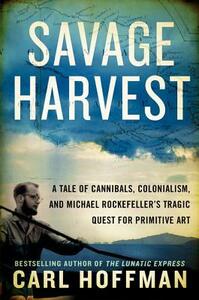You need to sign in or sign up before continuing.
Take a photo of a barcode or cover
92 reviews for:
Savage Harvest: A Tale of Cannibals, Colonialism, and Michael Rockefeller's Tragic Quest for Primitive Art
Carl Hoffman
92 reviews for:
Savage Harvest: A Tale of Cannibals, Colonialism, and Michael Rockefeller's Tragic Quest for Primitive Art
Carl Hoffman
I had never heard of Michael Rockefeller before I won this book in a giveaway. The story: was a Rockefeller heir eaten by cannibals on a Pacific Island in 1961? A journalist investigates first-hand on the island, including his own adventures and growth along the way, plus the continuing story of those former-cannibals. The book was interesting and kept a great pace. The story itself is so strange and fascinating that I guess it's hard to write a boring book about it! But it was well-written and the author's insights into himself and the society were interesting and thoughtful, with a good helping of self-skepticism about his preconceived notions of "primitive" peoples. It was a great read on something I'd have never known otherwise.
informative
medium-paced
Interesting story that not only tries to explain the disappearance of Michael Rockefeller, but also lightly covers the culture of cannabilsm
adventurous
informative
reflective
medium-paced
adventurous
challenging
dark
emotional
informative
sad
tense
slow-paced
Savage Harvest🍒🍒🍒
By Carl Hoffman
2014
"I think I can make it" were the last words by Michael Rockefeller, as he swam away looking for help after his catamaran capsized while crossing a river, with his friend Wassing. Wassing was eventually rescued. Sunburned and dehydrated, but he was still alive. Michael and/or his remains have never been found.
Travelling through the rivers and jungles of New Guinea, Michael Rockefeller was obsessed with collecting primitive art and artifacts from Agat and Asmat, tiny island undeveloped. He learned alot about the primitive legends and cultures of these people. Known to be violent and cannabalistic headhunters they had never seen a white man before Michaels expedition. These people have long been rumored to here captured Michael and still have his skull, but nothing can substantiate this. His family believes he drowned before reaching shore and refuse to discuss his death. They do not believe the cannibalism theory.
Whether he drowned.....was eaten by sharks...encountered cannibals......is still a mystery today. All we know, for sure, are his last words....."I think I can make it".
Well written and researched, this was a very interesting and engaging book. Recommended.
By Carl Hoffman
2014
"I think I can make it" were the last words by Michael Rockefeller, as he swam away looking for help after his catamaran capsized while crossing a river, with his friend Wassing. Wassing was eventually rescued. Sunburned and dehydrated, but he was still alive. Michael and/or his remains have never been found.
Travelling through the rivers and jungles of New Guinea, Michael Rockefeller was obsessed with collecting primitive art and artifacts from Agat and Asmat, tiny island undeveloped. He learned alot about the primitive legends and cultures of these people. Known to be violent and cannabalistic headhunters they had never seen a white man before Michaels expedition. These people have long been rumored to here captured Michael and still have his skull, but nothing can substantiate this. His family believes he drowned before reaching shore and refuse to discuss his death. They do not believe the cannibalism theory.
Whether he drowned.....was eaten by sharks...encountered cannibals......is still a mystery today. All we know, for sure, are his last words....."I think I can make it".
Well written and researched, this was a very interesting and engaging book. Recommended.
informative
mysterious
medium-paced
Michael Rockefeller was born in 1938 to Nelson and Mary Rockefeller. Michael attended Harvard University, graduating with honors. He served briefly in the United States Army. Once his military service ended, he decided to go to New Guinea on an expedition for the Peabody Museum, which is part of Harvard University. Michael worked as a sound recorder on this expedition. When it was over, he returned to New Guinea to study a different tribe. On this trip, Michael went missing. The circumstances surrounding his disappearance were subject to speculation for several reasons, but the fact is...he went missing. Michael has still never resurfaced.
This book was wonderfully researched and well written. The descriptions of the areas in New Guinea were very detailed, and the way the author pieced together the circumstances surrounding the vanishing on Michael Rockefeller was page turning. I really appreciated the way that this book held my attention while I learned about something I had never heard of before. This was, in a way, a history meets true crime book, which I really enjoyed.
This book was wonderfully researched and well written. The descriptions of the areas in New Guinea were very detailed, and the way the author pieced together the circumstances surrounding the vanishing on Michael Rockefeller was page turning. I really appreciated the way that this book held my attention while I learned about something I had never heard of before. This was, in a way, a history meets true crime book, which I really enjoyed.
adventurous
challenging
dark
medium-paced
The beginning of this book is a complete turn off. I almost gave up, but continued because it was a bookclub selection. It ended up being ok. In general I don’t find stories about billionaires putting themselves in harms way and then being harmed interesting. I think stealing art from people only to turn around and make millions of dollars off of it, giving the actual artists no credit, and in turn none of the profit, is disgusting. I don’t really care about what happened to Michael. The only redeeming parts of the book were when the author tried to genuinely understand the Asmat culture. I would have greatly preferred a book about that unrelated to the Rockefeller incident.
dark
informative
medium-paced
dark
informative
medium-paced
I read this book in bits and pieces over the course of six weeks. While I wouldn’t describe the book as a “mesmerizing whodunit” - I thought that Hoffman’s description of the culture of the Asmat people and their interactions with Dutch priests and Indonesian government officials in the mid twentieth century and the 2010’s was well done. It’s challenging to reconstruct Michael R’s experience through his own diary and photos, along with the writings of religious leaders and other non-native people who lived in New Guinea in the 1960’s - but Hoffman took his best shot. Hoffman himself lived in New Guinea and with the Asmat people for four months during two trips - including one month immersing himself with a man named Kokai and his family. Hoffman paints himself as being more sensitive to the culture of the Asmat than Michael R - at least that’s the impression I had. We really don’t know how Michael treated the people he met. However, his (MR’s) insistence on buying sacred bisj poles to put on display at his father’s museum in New York City struck me as insensitive. From a culture that has a long standing oral history, the story behind each bisj pole must be known, that to carry even one away is to take away a piece of culture - and Michael R had purchased 20 of them.
Hoffman was in the area 50 years after Michael’s death. Numerous Western influences, including Roman Catholicism, had been introduced and gained a foothold in those intervening years.
Hoffman was in the area 50 years after Michael’s death. Numerous Western influences, including Roman Catholicism, had been introduced and gained a foothold in those intervening years.






